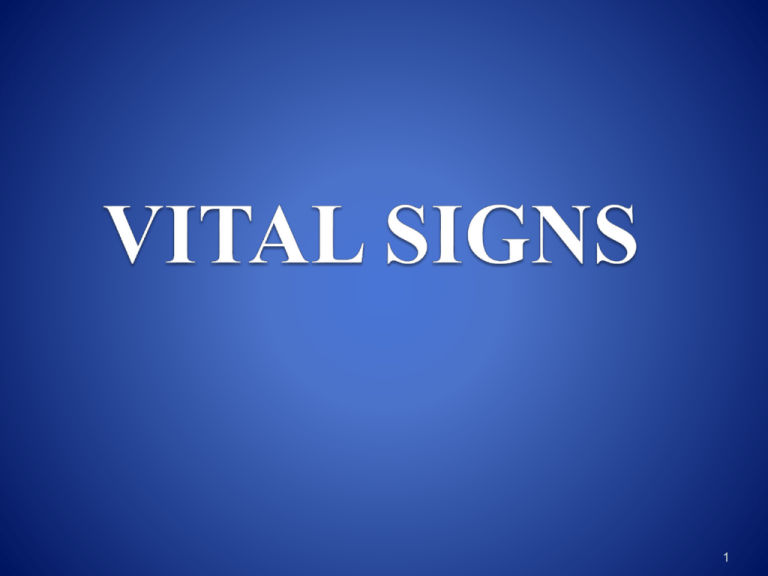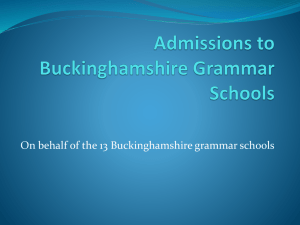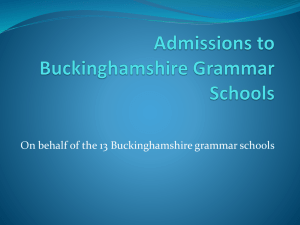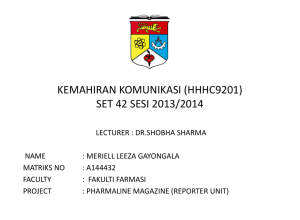Vital Signs Lecture
advertisement

1 VITAL SIGNS Indicators to distinguish between living and non living human being These are signs used by nurses, paramedics and physicians to follow-up the patient's condition or to detect any variation in them. 2 The vital signs include: Pulse Respiration Temperature Blood pressure Pupils Colors Level of consciousness Stroke pain Ability to move 3 PULSE Reflects the rate of the heart beat Felt where an artery passes over a bone near the surface (superficial) of the body. Normal heart rate (HR) ranges between 60-100 beats/min 4 RESPIRATION It is the means by which oxygen enters the blood through the lungs during breathing in (inspiration) and carbon dioxide is expelled during breathing out (expiration). Normal respiratory rate (RR) is 12-20 breath/min 5 TEMPERATURE Average body temp is 37 degrees centigrade (normal temp.36.5-37.2 C°) Taken by a clinical thermometer 6 BLOOD PRESSURE (BP) It means the force required by the heart to pump blood into the arteries. It is measured in systolic and diastolic pressure. Systolic- is known as the force exerted by the heart to overcome the resistance in the blood vessels. to pump blood out of the heart (during contraction = systole) Diastolic- is known as the force exerted by the heart to overcome the resistance if the vessels during resting period of the heart when the pressure falls, also known as the relaxation period of the heart pump Normal B.P. 120/80 mm/Hg Hypertension: High blood pressure if BP < 140/90 mmHg. Hypotension : Low blood pressure if BP > 100/60 mmHg. 7 PUPILS Check the pupils for size, equality and reactivity to light (both pupils constricted) Examine both eyes 8 COLOUR Color of the skin and mucous membrane, (conjunctiva, inside of the lips) 9 LEVEL OF CONSCIOUSNESS This is used during cardiac arrest, head injuries and any comatose patient to assess responsiveness Terms Used to Describe Level of Consciousness ■ Alert: Follows commands in a timely fashion. ■ Lethargic: Appears drowsy, may drift off to sleep during examination. ■ Stuporous: Requires vigorous stimulation (shaking, shouting) for a response. ■ Comatose: Does not respond appropriately to either verbal or painful stimuli. 10 How to assess level of consciousness LOC ??!! The Glasgow Coma Scale (GCS) provides a more objective way to assess the patient’s LOC. It evaluates best eye response, best motor response, and best verbal response on a scale of 3 to 15. Fifteen (highest score) indicates that the patient is awake, alert, oriented, and able to follow simple commands. Three (lowest score) indicates that the patient does not respond to any stimulus and has no motor or eye response, reflecting a very serious neurologic state with poor prognosis. 11 The Glasgow Coma Scale (GCS) OBSERVATION RESPONSE ELICITED Eye response Opens spontaneously 4 Opens to verbal command 3 Opens to pain 2 No response 1 Reacts to verbal command 6 Motor response SCORE Reacts to painful stimuli Verbal response Identifies localized pain 5 Flexes and withdraws 4 Assumes flexor posture 3 Assumes extensor posture 2 No response 1 Is oriented and converses 5 Is disoriented, but converses 4 Uses inappropriate words 3 Makes incomprehensible sounds 2 No response 1 Total scores 15 12 REACTION TO PAIN In case of cardiac arrest, response to painful stimuli can be tested A pin or sharper object can be used in assessing reaction to pain 13 ABILITY TO MOVE If the patient is conscious and if spinal or neck injury is suspected assess the patient's ability to move his upper and lower extremities. 14







